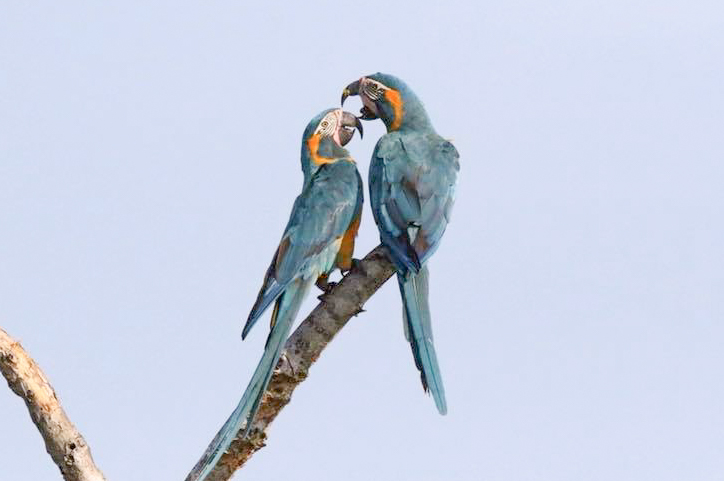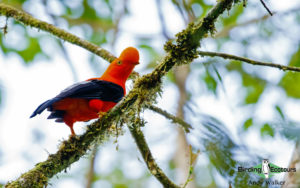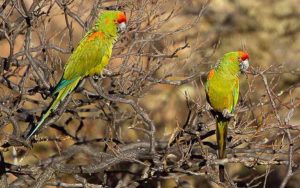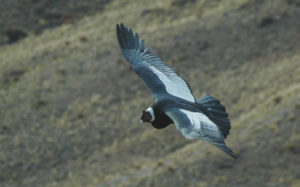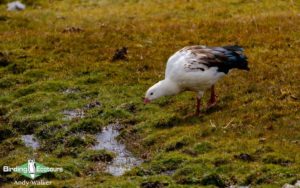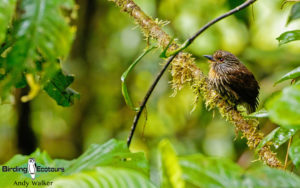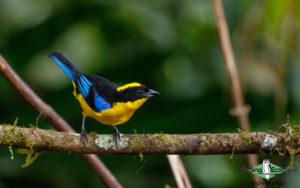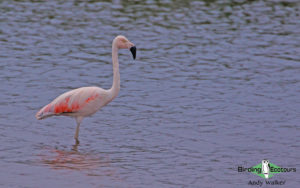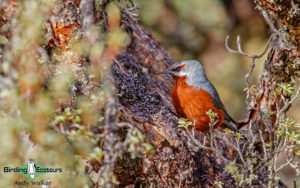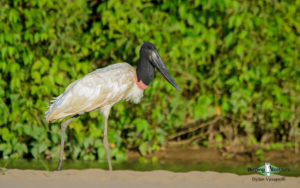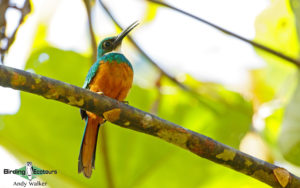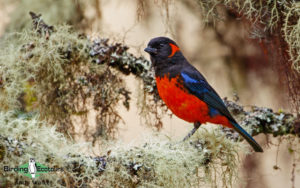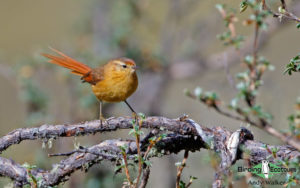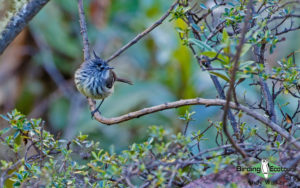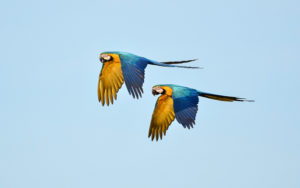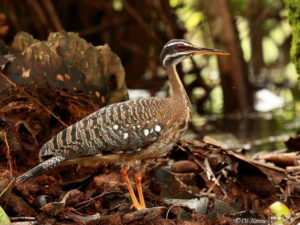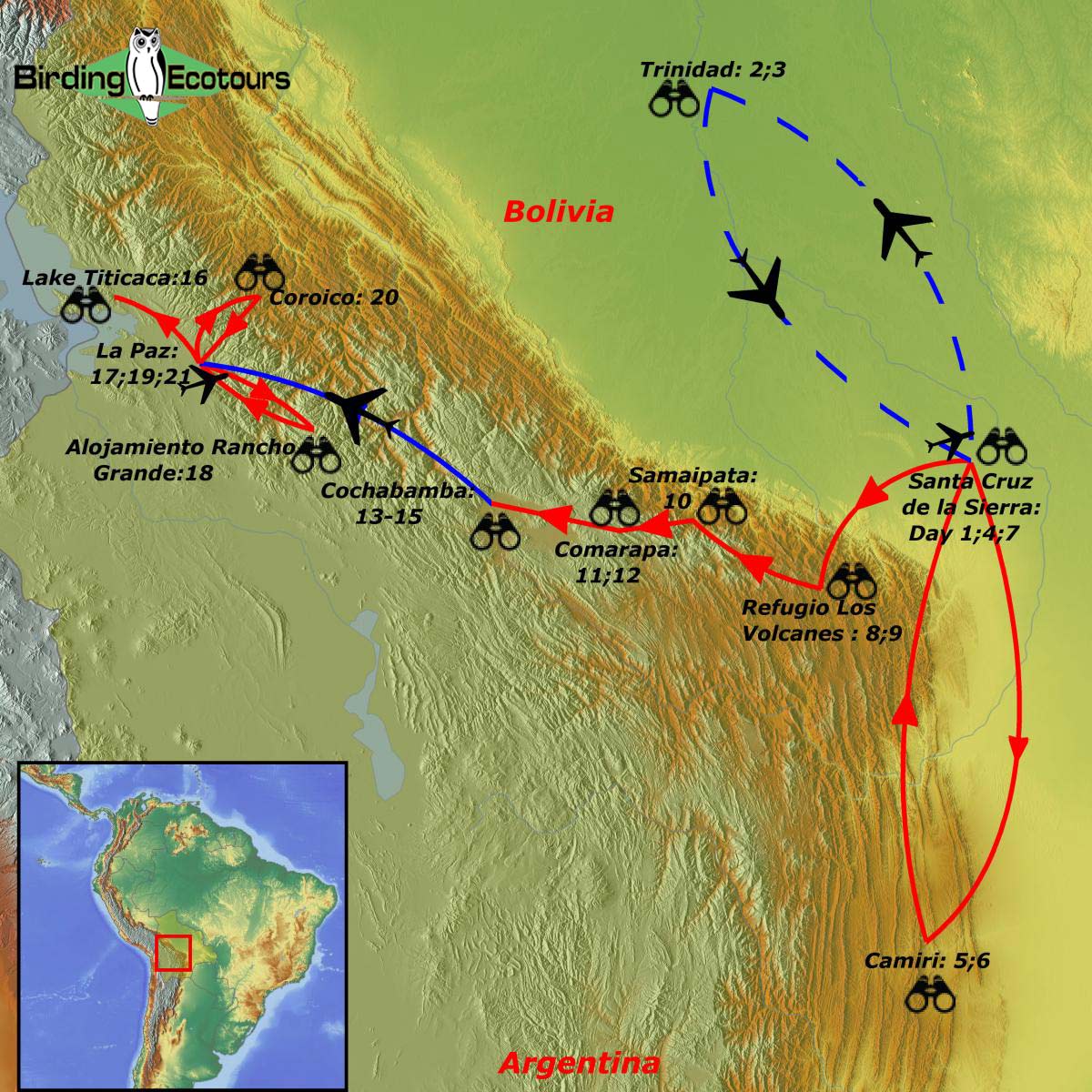Bolivia: Red-fronted Macaw, Yungas and Titicaca Grebe (with optional Blue-throated Macaw extension)
Go to: Bolivia Birding Tours | Birding Tours in the Neotropics | All our birding tours
Bolivia: Red-fronted Macaw, Yungas and Titicaca Grebe
(with optional Blue-throated Macaw extension)
We have temporarily suspended the set departure version of this tour shown here, because strikes prevented us from operating the 2022 trip, so please e-mail [email protected] if you want us to potentially run the trip for you privately by special request
Bolivia may be one of the less-frequently visited birding destinations in South America, but it has truly great potential and magnificent birds. The country holds 1,455 bird species, the sixth-largest country bird list after Colombia, Peru, Brazil, Indonesia, and Ecuador. There are 18 endemic bird species and Bolivia also holds several range-restricted and globally threatened birds that are very difficult to find elsewhere in South America. The reason for this impressive avian diversity is because of the large number of different ecosystems throughout this country. From Amazon rainforest through to cloudforest (Yungas) mountains, tropical and flooded savanna, cerrado, Chiquitania forest, and Chaco, to high Andean mountains and Lake Titicaca, the highest navigable lake in the world, Bolivia is likely the most biodiverse landlocked country on earth.
Blue-and-yellow Macaw is one of the commoner macaws we should see on this trip, along with the Critically Endangered (IUCN) Blue-throated Macaw.
Our 16-day Bolivian birding tour will give you the opportunity to explore the best that this country has to offer, including some unique southern South American habitats, such as the Chiquitania region in the Santa Cruz province, an area dominated by xerophytic vegetation with acacia-like trees, and lowland grasslands and surrounds near the Viru Viru International Airport. We will begin the tour’s birding close to the airport where we will be looking for Toco Toucan, Chopi Blackbird, Sayaca Tanager, White-bellied Nothura, Red-winged Tinamou, Campo Flicker, Yellow-chevroned Parakeet, and with luck, Greater Rhea.
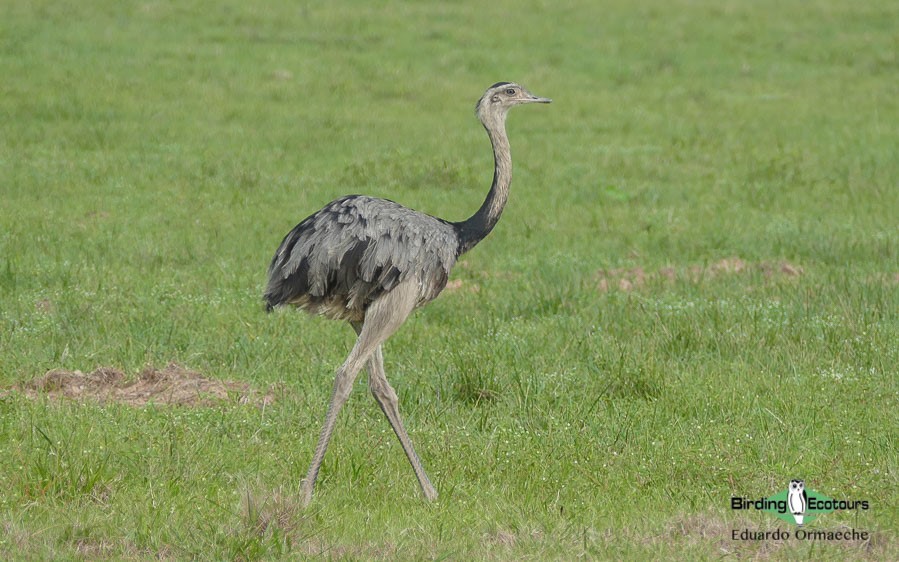
The lush tropical forest of the beautiful red-walled canyon near Bermejo at the edge of the Amboró National Park will be our next port of call. We will stay at the Refugio Los Volcanes Lodge, where we could find Bolivian White-crowned Tapaculo, Grey-throated Leaftosser, Military Macaw, Rufescent Screech Owl, Two-banded Warbler, Dusky-green Oropendola, Black-streaked Puffbird, Blue-browed Tanager, White-backed Fire-eye, Yungas Manakin, Yungas Dove, Ochre-cheeked Spinetail, Slaty Gnateater, and with some luck Bolivian Recurvebill.
Next, we will explore the dry valleys between Samaipata and Saipina in search of several range-restricted species such as Dot-fronted Woodpecker, Tucuman Amazon, and with luck the hard-to-find Red-faced Guan. In addition, we will search for the recently split Yungas Guan, Bolivian Earthcreeper, as well as the trio of Bolivian endemics Bolivian Blackbird, Cliff Parakeet, and Red-fronted Macaw.
Leaving the dry valleys behind, we will visit the cloudforest of the Siberia area, where we will look for Trilling Tapaculo, Light-crowned Spinetail, Pearled Treerunner, Fulvous-headed Brushfinch, and the endemics Black-throated Thistletail and Rufous-faced Antpitta.
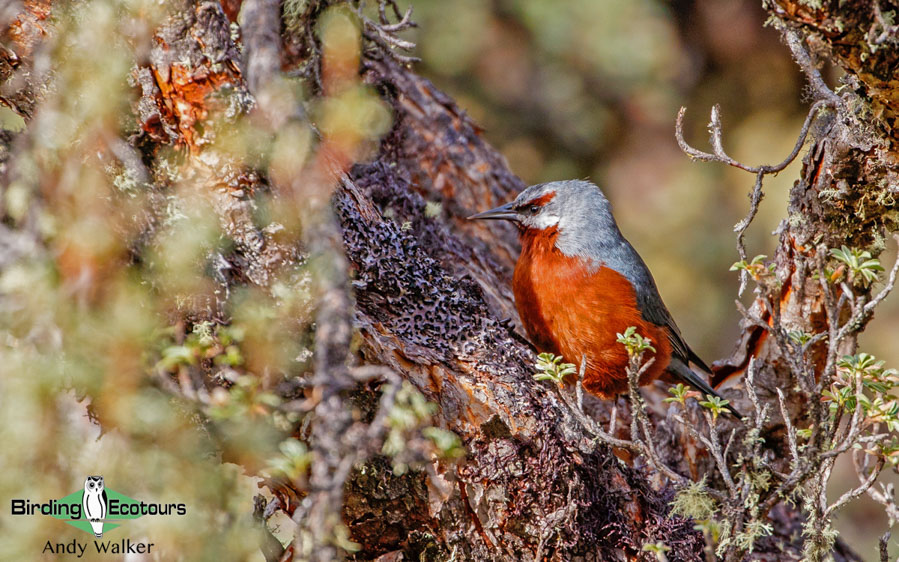
The city of Cochabamba, in the center of the country, at 2,550 meters (8,366 feet) above sea level, will be our base for the next four nights as we explore the slopes of the snow-capped Cerro Tunari, where several interesting species occur, such as the endemic Cochabamba Mountain Finch and Bolivian Warbling Finch. We will have a chance to see the gorgeous Red-tailed Comet, Andean Condor, and several Polylepis specials including Tawny and Brown-capped Tit-Spinetails, and Giant Conebill. The beautiful mountain scenery is a picture in itself with Andean Gull, Andean Goose, and Andean Lapwing further adding to the scene. The cloudforest and upper tropical foothills hold several range-restricted species that are otherwise found only in the extreme southeast of Peru and are hard to find there, such as Hooded Mountain Toucan, Orange-browed Hemispingus, Yellow-rumped Antwren, White-eared Solitaire, Blue-banded Toucanet, and Straw-backed Tanager.
Then we will fly to Bolivia’s capital city, La Paz to explore Lake Titicaca, looking for Titicaca Grebe, Chilean Flamingo, Andean Avocet, Yellow-winged Blackbird, and Many-colored Rush Tyrant. We will also explore other habitats in search of the endemic Berlepsch’s Canastero, and finally our journey will take us along the legendary “Death Road” that used to join the high Andes with the lush and humid Yungas. Along the different altitudinal sections of this road, we will look for high-elevation species such as Rufous-bellied Seedsnipe, Scribble-tailed Canastero, and Diademed Tapaculo as well as low-elevation species such as Versicolored Barbet, Yungas Tody-Tyrant, and Upland Antshrike.
For those who would like to target the Critically Endangered (IUCN) Blue-throated Macaw, we will be offering a three-day extension. On this short trip we will visit the Trinidad area where three pairs of this huge macaw live.
We invite you to join us on our fantastic Birding Ecotours Bolivia birding tour, which can also be combined with our preceding Paraguay: Birds and Wildlife Adventure.
Main itinerary (16 days/15 nights)
Day 1. Arrival at Santa Cruz de la Sierra and transfer to the hotel
Most flights normally arrive at the Viru Viru International Airport in Santa Cruz de la Sierra in the afternoon. If time permits, we will spend a couple of hours birding around the airport, looking for species such as Chopi Blackbird, Orange-backed Troupial, Rufous Casiornis, Toco Toucan, Yellow-chevroned Parakeet, White-bellied Nothura, Red-winged Tinamou, Campo Flicker, and Greater Rhea.
Overnight: Hotel Cortez, Santa Cruz de la Sierra
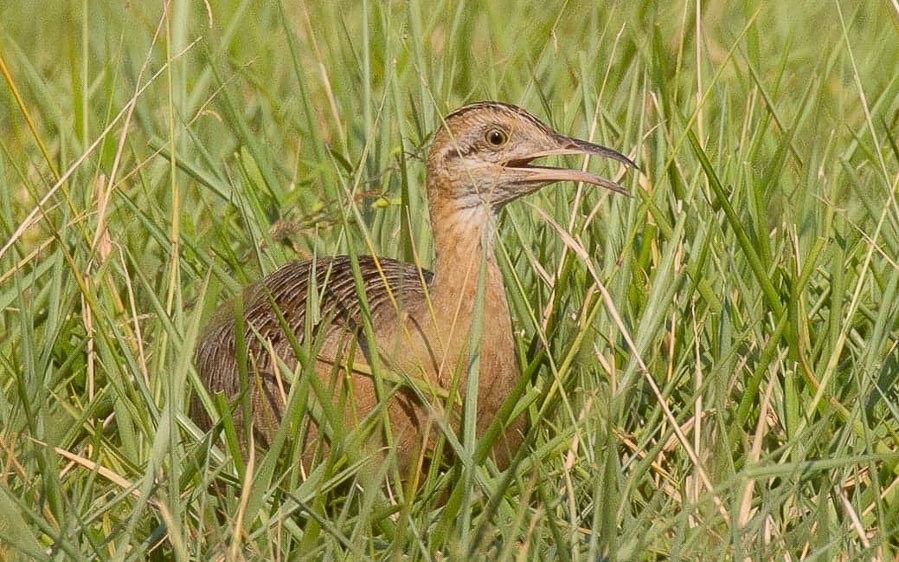
Day 2. Lomas de Arena and Santa Cruz Botanical Garden
We will have an early start to explore the Lomas de Arena Regional Park, where we will focus on Red-legged Seriema and White-eared Puffbird, and will search some nearby ponds for Ringed Teal. After a couple of hours here, we will be transferred to the Santa Cruz Botanical Garden where we will spend the rest of the morning looking for Bolivian Slaty and Great Antshrikes, Green-cheeked Parakeet, Fawn-breasted Wren, Blue-crowned Trogon, Amazonian Motmot, Chestnut-eared Aracari, Yellow-tufted and Golden-green Woodpeckers, Crowned Slaty and Suiriri Flycatchers, Purplish Jay, Creamy-bellied Thrush, Olivaceous and Buff-throated Woodcreepers, Black-capped Antwren, Flavescent and Golden-crowned Warblers, Guira Tanager, and Guira Cuckoo. With luck, we may find the elusive Stripe-backed Antbird. In the afternoon, we might return to the airport surroundings looking for Red-winged Tinamou and White-bellied Nothura, if we still need these target birds.
Overnight: Hotel Cortez, Santa Cruz de la Sierra
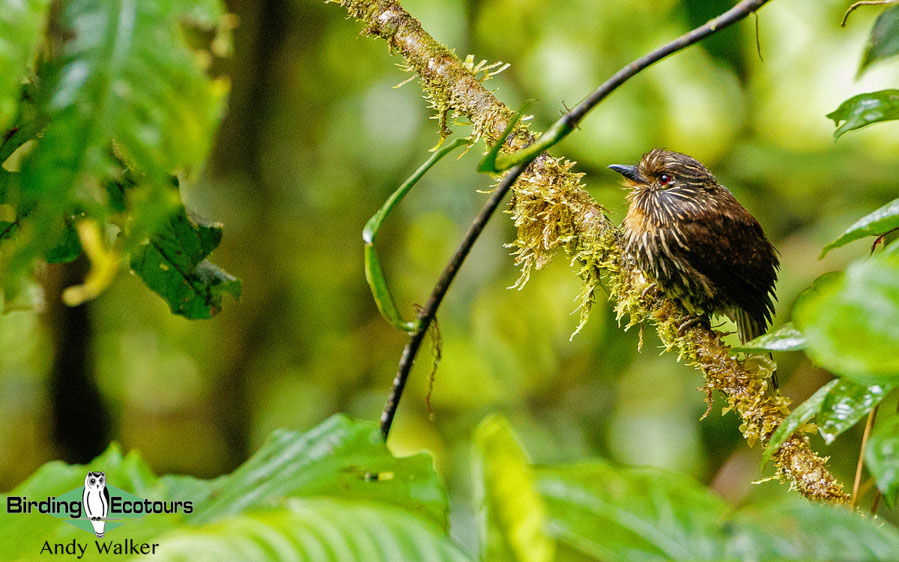
Days 3–4. Refugio Los Volcanes Lodge
We will have another early start, leaving Santa Cruz de la Sierra for Refugio Los Volcanes. This basic lodge (where we will spend two nights) is located in an outstanding location surrounded by rocky cliffs at the edge of the Amboró National Park. We will be looking for species such as Two-banded Warbler, Black-goggled and Blue-browed Tanagers, Dusky-green Oropendola, Plush-crested and Purplish Jays, Green-cheeked Parakeet, Military Macaw, Blue-throated Piping Guan, Striated Antthrush, Slaty Gnateater, Ochre-cheeked Spinetail, Bolivian White-crowned Tapaculo, Red-necked Woodpecker, Yungas Dove, Sunbittern, Black-streaked Puffbird, Yungas Manakin, and if we are lucky, the secretive duo of Bolivian Recurvebill and Grey Tinamou. At night, we will try for Rufescent Screech Owl.
Overnight: Refugio Los Volcanes Lodge
Day 5. Transfer to Samaipata
After a last morning’s birding around Refugio Los Volcanes, we will transfer to Samaipata.
Overnight: El Pueblito, Samaipata
Day 6. Quirusillas forest and transfer to Comarapa
We will have a very early start as we drive the unpaved road to the Quirusillas forest. This remote location holds a remnant patch of temperate Tucumán forest (a unique habitat found in this part of Bolivia and in northwestern Argentina). Our goal is to be there by dawn to look for Red-faced Guan, Tucuman Amazon, and Dot-fronted Woodpecker. Later we will descend into the dry valleys, dominated by scrub and cacti. Along our drive to Comarapa, we might see Blue-crowned Parakeet, Grey-crested Finch, White-fronted Woodpecker, White-tipped Plantcutter, and Black-and-rufous Warbling Finch.
Overnight: Monteblanco B&B, Comarapa
Day 7. Perereta for Red-fronted Macaw
Today we have an early start to drive to Perereta, a special place where the endemic Red-fronted Macaw roosts. These birds roost here and as such the sighting and chance of photographing this unique species is almost guaranteed. Other birds here include the endemic trio of Cliff Parakeet, Bolivian Earthcreeper, and Bolivian Blackbird, as well as Chaco Puffbird, Black-capped Warbling Finch, Rufous-sided Warbling Finch, Striped Woodpecker, and Spot-breasted Thornbird. On the way back to Comarapa we might see the elusive Giant Antshrike, the recently split Yungas Guan, and with luck, the majestic Andean Condor.
Overnight: Monteblanco B&B, Comarapa
Day 8. Siberia forest and transfer to Cochabamba
Today we will leave the dry valleys and climb in elevation as we explore the humid patch of montane forest above Comarapa, looking for the distinctive subspecies of Azara’s (Buff-browed) Spinetail, Light-crowned Spinetail, Trilling Tapaculo, Rufous-faced Antpitta (endemic), Common Bush Tanager, Olive-crowned Crescentchest, Bolivian, Fulvous-headed and White-browed Brushfinches, and with luck, the scarce Black-winged Parrot. We will then drive to a slightly higher elevation and try for the endemic Black-throated Thistletail. Later we will arrive at Cochabamba for a four-night stay.
Overnight: Hotel Diplomat, Cochabamba
Day 9. Birding the Cerro Tunari
Today we explore the Cerro Tunari, looking for the endemic Cochabamba Mountain Finch, Bolivian Warbling Finch, Brown-capped and Tawny Tit-Spinetails, Puna Tapaculo, Maquis Canastero, Cordilleran and Rusty-vented Canasteros, Streak-fronted Thornbird, Black-hooded Sierra Finch, Greenish Yellow Finch, White-capped Dipper, Andean Condor, Black-chested Buzzard-Eagle, Grey-hooded Parakeet, Puna Tapaculo, Tufted Tit-Tyrant, and the striking Red-tailed Comet.
Overnight: Hotel Diplomat, Cochabamba
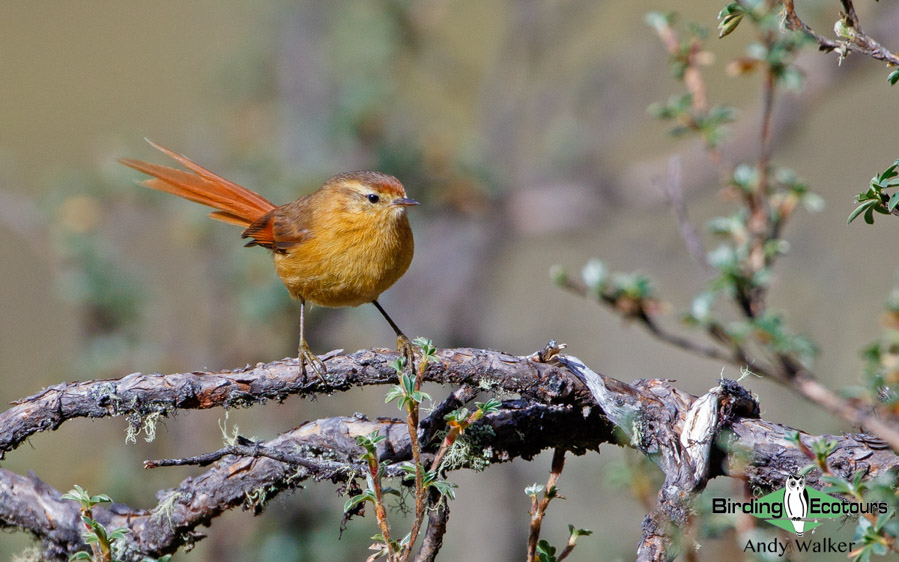
Day 10. Birding the upper Chapare
The Chapare area is the habitat of the localized Hooded Mountain Toucan and also White-eared Solitaire, the uncommon Orange-browed Hemispingus, and the rare Straw-backed Tanager. Other species include Yungas Pygmy Owl, Band-tailed Pigeon, Barred Antthrush, Blue-banded Toucanet, Grey-bellied Flowerpiercer, Scarlet-bellied and Hooded Mountain Tanagers, Grass-green Tanager, White-eared Conebill, Chestnut-crested Cotinga, Barred Fruiteater, and Southern Mountain Cacique.
Overnight: Hotel Diplomat, Cochabamba
Day 11. Birding the lower Chapare
We’ll have another day to bird the upper Chapare in case we missed some of our targets in the area. We will then descend in elevation, looking for the localized Yellow-rumped Antwren, Versicolored Barbet, Blue-banded Toucanet, and Upland Antshrike.
Overnight: Hotel Diplomat, Cochabamba
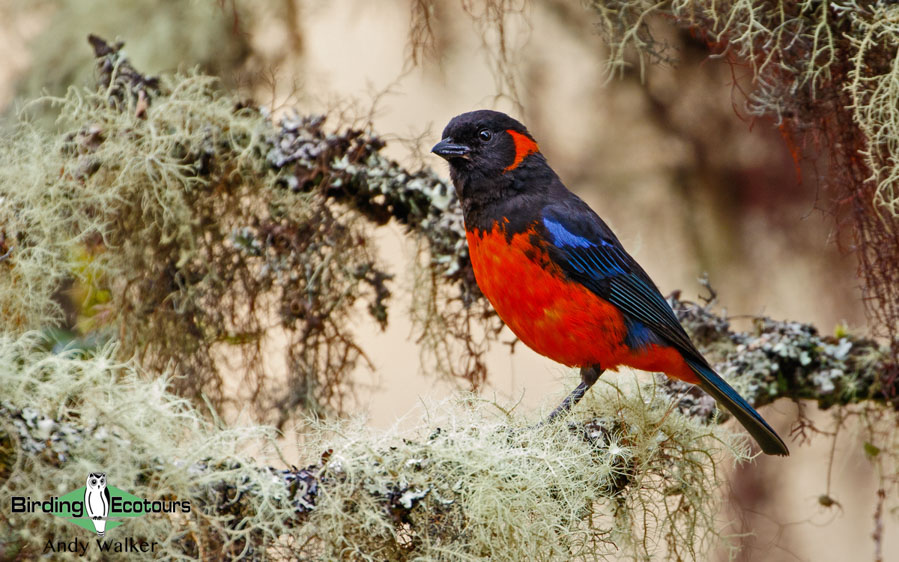
Day 12. Flight to La Paz, transfer to and birding at Lake Titicaca
We will have an early flight to La Paz, and on arrival at El Alto International Airport we will be transferred to Huarina along the shores of Lake Titicaca. The main target for today is the localized and most-wanted Titicaca Grebe, which is easy from the grounds of our comfortable hotel. Other birds include Yellow-winged Blackbird, Many-colored Rush Tyrant, Wren-like Rushbird, Spot-winged Pigeon, Yellow-billed Teal, Yellow-billed Pintail, Andean Duck, Puna Teal, Andean Gull, Chilean Flamingo, Plumbeous Rail, Andean Goose, Andean Lapwing, and Cinereous Harrier.
Overnight: Inca Utama Hotel, Lake Titicaca
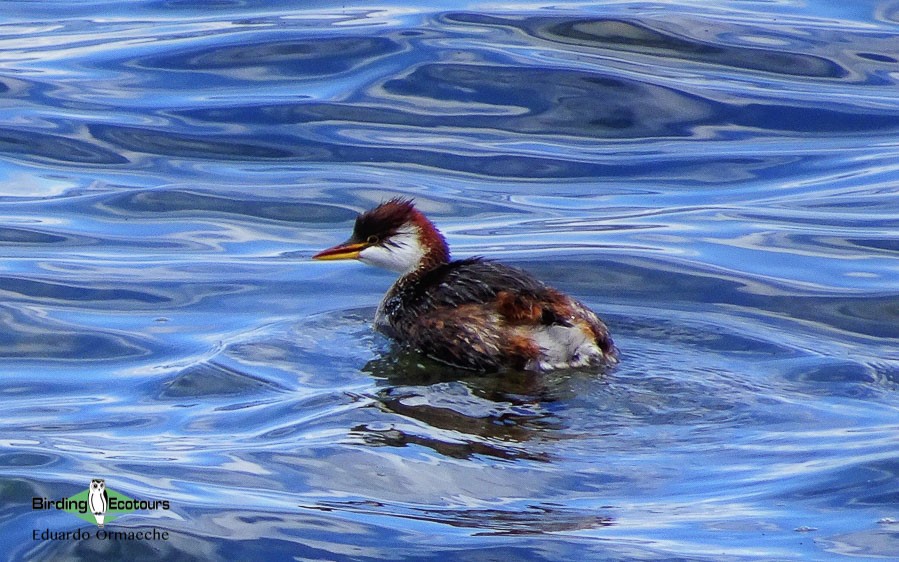
Day 13. Search for Berlepsch’s Canastero
Today’s excursion will take us to Sorata to look for the endemic and localized Berlepsch’s Canastero and other high-Andes species. Then we will drive back to La Paz for an overnight.
Overnight: Hotel in La Paz
Day 14. Birding La Cumbre and Coroico Road
Today we will explore the high-elevation mountain pass of La Cumbre at the base of the snow-capped mountains, at an altitude of over 14,400 feet (4,000 meters). Surrounded by stunning scenery, we will look for Rufous-bellied Seedsnipe and Grey-breasted Seedsnipe and at slightly lower elevation for Scribble-tailed Canastero and Diademed Tapaculo.
We will reach the famous Coroico Road (once the infamous Death Road), which is used these days only by cars and mountain cycles. Here we will look for the scarce Scimitar-winged Piha, Band-tailed Fruiteater, Rufous-capped Antshrike, Bolivian Tyrannulet, Mountain Wren, Fulvous Wren, Blue-winged Mountain Tanager, Andean Solitaire, Drab Hemispingus, and Orange-browed Hemispingus. Then we will descend to Coroico in the tropical Yungas.
Overnight: Rio Selva Resort, Coroico
Day 15. Coroico Road and transfer to La Paz
We will spend the morning looking for the localized Brown Tinamou, Upland Antshrike, Andean Cock-of-the-rock, Stripe-chested Antwren, and Torrent Duck. In the afternoon, we will return to La Paz.
Overnight: Hotel in La Paz
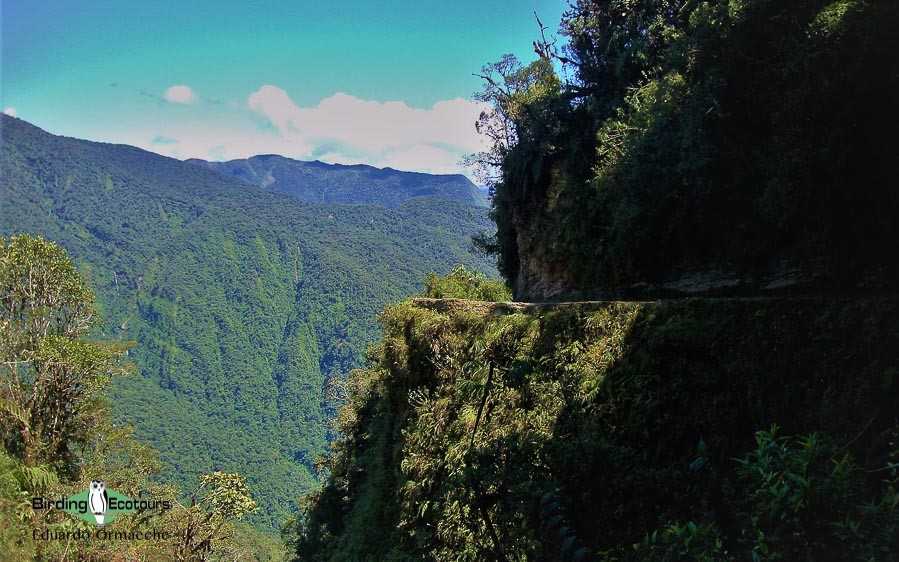
Day 16. Transfer to El Alto International Airport and departure
You will be transferred from La Paz to El Alto International Airport to connect with your international flight home, or if you are joining us for our Blue-throated Macaw extension, we will catch flights to Trinidad.
Blue-throated Macaw extension (3 days/2 nights)
Day 1. Flight from La Paz to Trinidad
We will start this tour on the final day of our main Bolivia tour where we will catch flights from La Paz to Trinidad, in the Beni Department. We will spend the afternoon birding the Trinidad area. The wetlands of Trinidad provide good numbers of species like Jabiru, Wood Stork, Roseate Spoonbill, Limpkin, and Wattled Jacana. We will also look for Snail Kite, Black-collared Hawk, Long-winged Harrier, the local subspecies of Plain Softtail, and Velvet-fronted Grackle, Greater Thornbird, Grey-crested Cacholote, Black-collared Hawk, Snail Kite, and White-bellied and Rusty-collared Seedeaters.
Overnight: Tapacare Resort, Trinidad
Blue-throated Macaw will be targeted on our extension (photo Jose Luis Avendaño).
Day 2. Loreto Road and Blue-throated Macaw
We will depart early in the morning to look for our main target here, the Critically Endangered (IUCN) Blue-throated Macaw. Until 1992, the natural habitat of this species was completely unknown, and with fewer than 250 mature individuals left in the wild, it is one of the most endangered bird species in the world. Around Trinidad there is an accessible site where three pairs live. We will also look for other species such as Blue-and-yellow, Red-and-green, and Chestnut-fronted Macaws, Mato Grosso Antbird, White-lored Spinetail, Narrow-billed and Great Rufous Woodcreepers, White and Black-and-white Monjitas, South American Snipe, Large-billed and Yellow-billed Terns, Undulated Tinamou, Scarlet-headed Blackbird, Solitary Cacique, and White-tailed Goldenthroat.
Overnight: Tapacare Resort, Trinidad
Day 3. Departure from Trinidad
We will spend the morning birding in Trinidad visiting the Chuchuni Ecological Reserve, where we might find species such as Hoatzin, Sunbittern, Black-tailed and Blue-crowned Trogons, Chestnut-backed, Great and Barred Antshrikes, Band-tailed Antbird, Buff-throated Woodcreeper, Band-tailed Manakin, Purplish Jay, Plain-crowned Spinetail, Fawn-breasted Wren and White-backed Fire-eye. With luck we might find the secretive Bare-faced Curassow, Undulated Tinamou or Pheasant Cuckoo. We will then transfer in the afternoon to Trinidad Airport where you can catch your flight home.
Please note that the itinerary cannot be guaranteed as it is only a rough guide and can be changed (usually slightly) due to factors such as availability of accommodation, updated information on the state of accommodation, roads, or birding sites, the discretion of the guides and other factors. In addition, we sometimes have to use a different international guide from the one advertised due to tour scheduling.
Download ItineraryBIRDING TOUR BOLIVIA: THE ANDES AND THE CHACO LOWLANDS
TOUR-SPECIFIC INFORMATION
ARRIVAL INFORMATION
Our tour will start in the city of Santa Cruz de la Sierra in Bolivia. You can reach Santa Cruz de la Sierra by several international flights coming from cities such as Lima, São Paulo, Miami, and Madrid. Please consult your travel agent to book the most convenient flight. Your Birding Ecotours tour leader will be waiting for you at Viru Viru International Airport with a small board with the Birding Ecotours logo and then transfer you to your hotel in a private shuttle.
Please be aware that most international flights arrive in Santa Cruz de la Sierra in the afternoon, so we do not have any official birding activity planned for day 1. In case you arrive on an early flight you will be transferred to the hotel and will have to wait until check-in is available. For an early check-in you might be charged an extra fee directly by the hotel, which is not included in the Birding Ecotours tour price. When arriving at the airport please remember to keep your luggage tags, as they are required to exit the terminal at the Santa Cruz de la Sierra airport. Depending on time and weather we can spend a couple of hours of afternoon birding around the terminal’s grasslands.
DEPARTURE INFORMATION
After an incredible 22 days our tour will end in the city of La Paz. We will say fairwell the previous evening, and you will be transferred on the following day to El Alto International Airport to connect with your international flights. El Alto International Airport is located at a distance of 25 kilometers (15 miles) from La Paz, which can take an hour or more due to frequent serious traffic jams. We ask you to take precautions and leave the hotel early enough to avoid any unforeseen problems.
PHYSICAL REQUIREMENT AND PACE
This trip combines easy, moderate, and difficult legs. You will start the trip in the Bolivian lowlands. Santa Cruz de la Sierra, Trinidad, and the Chaco are lowlands at elevations from 170 to 760 meters (557 to 2400 feet). We will spend a week at these elevations. The weather is hot in the lowlands with temperatures that oscillate between 26 °C and 40 °C (78 °F and 104 °F). In this environment most of the birding is on flat grounds along roads, close to the vehicles, and from the vehicles.
There are some hilly, steep trails at Refugio Los Volcanes, which we will hike on foot at 1470 meters (5400 feet) above sea level. They are not difficult but require a certain level of fitness. Birding the inter-Andean valleys between Samaipata and Cochabamba will be relatively easy, similar to the first leg of the trip. Once we reach the high-elevation areas of Cochabamba such as Cerro Tunari, La Cumbre, and Lake Titicaca the elevation increases to 4000 meters (13,124 feet) above sea level. Most of the birding will be near the vehicle and walking on roads, but the high altitude and the lack of oxygen might affect those participants which are not used to such high elevations. We will spend a night in Huarina at the shores of Lake Titicaca, which ranks among the highest elevations of the trip, but the hotel is very comfortable, and medical oxygen is available in the hotel in case of any potential altitude sickness.
Bolivia is the fifth-largest country of South America and sadly among the lesser-developed ones with the poorest road infrastructure in the area. We will face long drives and early starts on almost every day of the trip. However, we have chosen the most comfortable places available for our guests.
Overall the trip is not any harder than any other birding trip in terms of walking and hiking, but we will face bad roads, long drives (five to nine hours in some cases), and high elevation for the last seven days of the trip.
MEDICAL AND TRIP CANCELLATION INSURANCE
All tour participants are strongly advised to obtain adequate medical cover prior to any tour, to take steps to ensure that all valuables are covered against damage, loss, or theft, and to obtain travel insurance for loss of luggage, unforeseen delays, or cancellation of the trip due to events like delayed flights, adverse weather conditions, or civil unrest.
We strongly recommend to purchase trip cancellation insurance, as Birding Ecotours will not give a refund on deposits or balance payments if the trip is canceled for any reason whatsoever, including but not limited to illness and death. Participants should consider insurance that covers any medical expenses, evacuation expenses, and trip cancellation expenses in case a participant has to leave the tour for any reason unrelated to Birding Ecotours. Note that some hospitals and doctors in South America will ask for advance payment before providing any medical attention. We advise you to get a plan that ensures cover of all medical care and evacuation that applies to your country of residence.
MEALS
Due to the early starts we will have on the trip and the remote locations we will visit breakfast and lunch will be served in the field, but we will have hot meals for dinner in restaurants and hotels. In restaurants we have two options of menu with always a vegetarian option. In lodges we have a fixed meal. Please let us know in advance about any diet restriction or preferences. However, we do our best to provide you with the most varied options during the trip. Water is included during the trip. Drinks, including soft drinks, fruit juices, and alcoholic beverages, are not included in the tour price.
MONEY
The official Bolivian currency is the boliviano. One US dollar equals 6.90 bolivianos.
We recommend that you bring US dollars. Often traveler’s checks are difficult to change, and this is not possible everywhere, especially in remote areas. We cannot spend birding time or scheduled time looking for financial institutions where you could cash these checks.
Your Birding Ecotours birding tour is an almost all-inclusive tour. You might need some money to cover personal expenses such as drinks, alcoholic drinks, laundry service, phone calls from the hotel, bar expenses, souvenirs and gifts you want to take home, or any non-mandatory gratitude you would like to give to any person who you think has provided exceptional service.
ATM machines are available in Santa Cruz de la Sierra, Cochabamba, and La Paz. Be aware that credit cards are not accepted everywhere, especially in remote locations. ATMs only provide bolivianos. We recommend that you get an amount you think you might need at the Santa Cruz de la Sierra airport immediately at your arrival. You will find exchanges at the airport.
We ask you not to bring US dollar bills that are damaged in any way (broken tips and edges, ink marks, pieces of tape on them, etc.) Most institutions and people do not accept US dollars that show this kind of damage.
HEALTH
Please carefully read the Center for Disease Control advice for Bolivia, including their recommendations about malaria. We also ask you to follow your doctor’s advice.
Although not a requirement for entry into Bolivia, unless you arrive from an infected area in another country, a yellow fever vaccination is a good idea for most people traveling to tropical third-world countries, and the vaccination is good for ten years. People with compromised immune systems should consult with their personal physician before getting any vaccination.
Hepatitis A, B, and C as well as polio, tetanus, and typhoid protection are recommended.
Dengue fever, carried by day-flying Aedes egypti mosquitoes, does occur in Bolivia, but no vaccine is yet available. To prevent mosquito bites we recommend to wear long-sleeved shirts and long pants, treat clothes with repellents like permethrin or use permethrin-treated clothing (such as Buzz Off), and use an EPA-registered mosquito repellent containing DEET.
Diarrhea is always a tricky hazard traveling in South America. Even though many travelers escape untouched we ask you to consult your doctor and bring some medicine to threat diarrhea like Imodium or Ciprofloxacin 500mg. We recommend drinking only bottled water and not eating at any street vendors if you are suspicious about the hygienic conditions. Follow your tour leader’s suggestions.
We take care of the places where we go for meals and the food we prepare in the field. We ask you to clean your hands using hand sanitizer. Please note that sometimes the change in the normal diet might show some mild stomach digestive abnormalities that may disappear in a short time. Only when this problem is followed by nausea, sickness, or fever there may be a real infection problem. Again, please ask your doctor what he recommends as best for you.
Please let us know any medical condition you may have such as diabetes, asthma, allergies, heart conditions, knee, back, or neck problems, including phobias or anything else you think we should know in order to take care of you and suggest what is best for you.
WEATHER
The weather will be hot and humid in the tropical lowlands with temperatures of 26 °C to 40 °C (78 °F to 104 °F) in places such as Santa Cruz, Trinidad, Camiri, and Coroico, but it will be less hot in the inter-Andean valleys such as Samaipata and Comarapa, where it can be hot in the morning but cool and windy in the afternoon.
La Paz, El Alto International Airport, and La Cumbre can be cold with temperatures around 5 °C to 8 °C (41 °F to 46 °F).
INSECTS
Insects should not be a big problem over most of our route, but we recommend that you wear loose-fitting long pants and long-sleeved shirts and keep insect repellents handy. Spraying shoes, socks, and the lower portion of pants with insect repellent will help reduce problems with chiggers.
Chiggers are burrowing mites that are found in the Americas from the United States to Argentina in hot areas. They occur on grass, and even though they do not spread any kind of disease their bites produce long-term itching as an allergic reaction. We recommend spraying insect repellent on feet and socks and lower legs to avoid chiggers. The forest holds all kind of insects such as mosquitoes, sandflies, blackflies, no-see-ums, and horseflies but never in large enough amounts to present a real problem. Ticks are uncommon in this part of Bolivia.
WHAT TO BRING
Equipment:
-Binoculars (of course)
-Spotting scope (optional) The leader will have a spotting scope for general use of all participants. However, we ask you to have quick views of the birds in order to allow everybody to have good views, especially of elusive species. If you like to enjoy long scope views of species at all times you might consider bringing your own scope. Digiscoping is not allowed with the tour leader’s scope.
-Alarm clock
-Flashlight
-Batteries
-A small notebook and pen to takes notes in the field
Personal Items:
-Grooming kit
-Glasses if you wear them
-Personal medication. We recommend bringing your prescription if you think you may need to buy any serious personal medication in local pharmacies.
-Sunscreen
-Sunglasses
-Waterproof plastic bags to keep your passport, wallet, and other valuables safe
-Umbrella (we recommend an umbrella rather than a waterproof jacket)
Clothing
-Long-sleeved shirt to be in the field (especially when walking forest trails)
-A regular t-shirt to feel comfortable while resting in the lodges and in the cars
-A regular shirt to be dressed for some dinners-and-checklist sessions
-Hiking boots to walk in the field, especially along forest trails. We will cover all kinds of terrain including paved roads, unpaved dirt roads, steep forest trails, grassy surfaces, rocky roads, and sandy surfaces. We might even have to walk on slightly muddy trails.
-Another pair of shoes to be comfortable during the drives, flights, and for meals. You may also bring sandals to be comfortable in your room and during spare times.
-A warm hat
-A warm jacket
-Waterproof pants
Please avoid nylon or plastic jackets and/or rainwear of similar materials that produce noise when we are owling.
SECURITY
The Bolivian countryside in all the areas that we visit are now quite safe, and you will find that Bolivians are friendly and helpful in general. Big cities, however, suffer the same problems as large cities anywhere, and you should take precautions to safeguard your personal belongings such as money, passport, and optical equipment. We recommend using money belts or security pouches worn inside your clothing. Avoid walking at night in large cities without informing your tour leader, and do not walk in big cities displaying binoculars and big cameras. We will be birding close to the Paraguayan border in the remote Chaco, so please be not surprised if we are stopped by military police; they are just checking what we are doing in the area.
ELECTRICITY
Bolivia uses 230 volts. We recommend bringing your electric converters and adapters to fit your electric devices. Bolivia uses A and C electricity plugs https://www.worldstandards.eu/electricity/plugs-and-sockets/.
PASSPORT AND VISA
A passport valid for at least six months beyond your planned departure is required. We recommend having a few blank pages in your passport; some countries require a full page for their stamp. Bring a few copies of your main passport page as well as details of your consular representation in Bolivia. Citizens of the US, Canada, Australia, New Zealand, the UK, Europe, and Japan as well as countries that belong to the Latin-American MERCOSUR trade bloc do not require visa to enter Bolivia. Citizens from Africa, Asia, Central America, and the Caribbean as well as Puerto Rico, Surinam, and Guyana should check directly with the Bolivian representation in their country about any requirements and visa they might need to enter Bolivia.
LAUNDRY
Laundry service is available in Santa Cruz de la Sierra, Cochabamba, and La Paz. Laundry fees are not included in the tour price.
PHOTOGRAPHY
We recommend that you bring all the photographic gear you may need because photographic equipment is difficult to find in Bolivia, especially in remote areas that we will visit.
Please ask permission of the local people before taking any photos of them. Some of them may feel that it is OK, while others may feel disturbed, and yet others, especially in tourist zones, may charge money or even might react aggressively.
Bird photographers are welcome, and the opportunities to photograph birds are good, but our tour is birding orientated. We will not waste time searching for birds that have been seen by the group if somebody needs a photo or even an upgrade photo. Our birding schedule is not always associated with the best light conditions for photography. Your tour leader doesn’t waste any client time on personal photography.
LUGGAGE
For the domestic flight to Trinidad you are allowed one piece of luggage of 20 kilograms (44 pounds) as checked luggage and five kilograms (11 pounds) as carry-on luggage. If your luggage is heavier you will have to pay a fee, which is not included in the tour price. We ask you to put a sign with your name and contact information on your luggage.
BOLIVIA DEMONSTRATIONS
Political unrest is common in Bolivia. The wealthier lowlanders of the Santa Cruz and Beni departments are trying to maintain autonomy from the current socialist government, which wants to centralize power and most major industries. Due to this political disagreement, Bolivia has been the scene of major protests, strikes, and demonstrations. Normally these issues are dealt with by blocking roads, particularly the highway between Santa Cruz de la Sierra and Cochabamba, which normally happens once or twice per year and sometimes might not happen for a few years at all. Our 2019 tour was cut short by political unrest as the trip happened soon after a national election, but otherwise thankfully we haven’t encountered problems since we started operating Bolivian birding tours in 2013. If this should happen again during our trip like it did in 2019, we will do everything in our power to minimize the impact on our tour, but you should be aware that the tour might suffer some itinerary shuffles, unexpected downtime, or even a re-routing of international flights. Should the situation become unsafe (which, currently, is unlikely; most demonstrations are not violent, and tourists are not a target), cancellation of the tour, perhaps just prior to the tour departure or even during the tour, is a possibility. Travel insurance usually covers this well (and did for the 2019 trip).
ACCOMMODATION
We use very comfortable accommodation in cities such as Santa Cruz de la Sierra, Huarina (Lake Titicaca), Trinidad, and Cochabamba. You can expect all the usual comfort in these hotels. The Hotel in Camiri is comfortable enough, with private bathroom, air conditioning, and WiFi, but there is not much service or staff to provide extra services to the guest. In La Paz we use a hotel bed-and-breakfast style, which is strategically located to avoid the infernal traffic jams in the city. The Hotel in Samaipata is rustic but very charming, and the food is delicious; it normally ranks as one of the favorites for our guests. Refugio Los Volcanes is rustic, simple, and relatively old and provides only a room with en-suite bathroom and three meals per day. The accommodation in Comarapa (the most remote location we will visit on the tour) is very basic, with just your room and private bathroom but no service at all.
‘Bolivia was a place on my wish list for some time. Unfortunately, the time I picked to go happened to be a time of political unrest. But, in spite of that, Eduardo and the Birding Ecotours team did an amazing job of keeping us all safe and still managing to take us to some special places to see some special birds. The endemic and critically endangered Blue-throated Macaw was a real highlight. Sadly, the trip was cut short due to the state the country at the time, but the professionalism of Birding Ecotours never came into question. I felt safe in their hands and would travel with them again anytime.’
Anne
